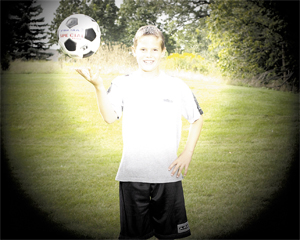Living with Open Angle Glaucoma
Glaucoma is a group of eye diseases in which the optic nerve at the back of the eye is slowly destroyed. Glaucoma damages a part of the eye called the optic nerve. The optic nerve receives light from the retina and transmits impulses to the brain that we perceive as vision.
 Primary open angle glaucoma is the most common type of glaucoma and is caused by the eyes drainage canals becoming clogged over time. This clogging causes the inner eye pressure (also called intraocular pressure of IOP) to rise because fluids cannot drain from the eye properly. The constant pressure eventually damages the optic nerve in the back of the eye.
Primary open angle glaucoma is the most common type of glaucoma and is caused by the eyes drainage canals becoming clogged over time. This clogging causes the inner eye pressure (also called intraocular pressure of IOP) to rise because fluids cannot drain from the eye properly. The constant pressure eventually damages the optic nerve in the back of the eye.
Glaucoma in all forms is referred to by Prevent Blindness America as “the sneak thief of sight”, because people usually do not know notice any signs of the disease until they have already lost significant sight. More than 2.2 million Americans age 40 and older suffer from open angle glaucoma. At least half of those do not know they have it.
Symptoms
Damage progresses very slowly and destroys vision gradually, starting with the side vision or what is called peripheral vision. One eye covers for the other, and the person remains unaware of any problem until a majority of nerve fibers have been destroyed, and a large part of vision has been destroyed and straight ahead vision is affected. This damage is irreversible.
Who is at risk?
Although anyone can get glaucoma, some people have a higher risk, those with;
• Age over 45 years
• A family history of glaucoma
• Diabetes
• Migraine
• Short sightedness (myopia)
• Eye injuries
• Blood pressure
• Black racial ancestry
• Past or present use of cortisone drugs (steroids)
People in these groups should have their first eye check no later than the age of 35. For most people, it is recommended to have an eye check for glaucoma by the age of 40.
The disease is six to eight times more common in African-Americans (in whom it is the leading cause of blindness) than in Caucasians, and six times more common in people over age 60 than in younger people.
How do does the doctors test?
Regular eye examinations are the best way to detect glaucoma early.
A glaucoma test usually includes the following:
Optic nerve check with an ophthalmoscope
Eye pressure check (tonometry)
Visual field assessment if needed - this tests the sensitivity of the side vision, where glaucoma strikes first
What are the types of Glaucoma?
Chronic (primary open-angle) glaucoma is the most common form of this disease. However, other forms occur:
Low-tension or normal tension glaucoma. Occasionally optic nerve damage can occur in people with so-called normal eye pressure. This form of glaucoma is treated in the same manner as open-angle glaucoma.
Acute (angle-closure) glaucoma. Acute glaucoma is when the pressure inside the eye rapidly increases due to the iris blocking the drain. An attack of acute glaucoma is often severe. People suffer pain, nausea, blurred vision and redness of the eye. Immediate medical help should be sought. If treatment is delayed there can be permanent visual damage in a very short time..
Congenital glaucoma. This is a rare form of glaucoma caused by an abnormal drainage system. It can exist at birth or develop later. Parents may note that the child is sensitive to light, have enlarged and cloudy eyes, and excessive watering. Surgery is usually needed.
Secondary glaucoma. This glaucoma can develop as a result of other disorders of the eye such as injuries, cataracts, and eye inflammation. The use of steroids (cortisone) has a tendency to raise eye pressure and therefore pressures should be checked frequently when steroids are used.
Treatments
Treatment cannot recover what has been lost, but it can arrest, or at least, slow down the damage process. That is why it is so important to detect the problem as early as possible, to be able to start treatment with as little damage to the vision as possible. Primary open angle glaucoma often responds well to medication if diagnosed and treated early on.
Eyedrops - these are the most common form of treatment and must be used regularly. In some cases pills are prescribed. The drops can be varied to best suit the patient and the type of glaucoma.
Oral medications- when eye drops alone do not bring down eye pressure doctors may prescribe oral medications.
Laser (laser trabeculoplasty) - this is performed when eye drops do not stop deterioration in the field of vision. In many cases eye drops will need to be continued after laser. Laser does not require a hospital stay.
Surgery (trabeculectomy) - this is performed usually after eye drops and laser have failed to control the eye pressure. A new channel for the fluid to leave the eye is created.
Coping and Support
Since glaucoma has no cure, a diagnosis generally means lifelong treatment and regular checkups. Meeting and talking to other people with glaucoma can be very helpful, and many support groups exist. Check with hospitals and eye care centers in your area to find local groups and meeting times. The Glaucoma Service Foundation to Prevent Blindness offers general information and coping tips in addition to an online glaucoma chat room twice a month. Many other online support groups exist as well.
For additional information or to schedule an Eye Examination, please contact us at (866) 611-7556.
Also Serving:
Sealy, TX - Bellville, TX - Columbus, TX - Katy, TX |
